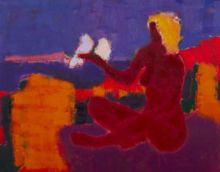An exhibit of the famous Ukrainian abstract artist Petro Lebedynets has opened in the art gallery “Art Collection.” The presented collection is named “Allegory.” It includes a series of 12 paintings, featuring the image of a woman. The paintings from this series do not have any special names, only numbers. The author notes that all the paintings are dedicated to the same topic; hence there is one name for all of them. Most of the paintings feature abstract images with a symbolic implication: plastic, graceful figure of a dreaming goddess against the background of mountains or clouds. Each painting is also a separate piece of art with special plastic and color characteristics and each of them is a “chapter” in the story called “Allegory.” Ukrainian art connoisseurs know Lebedynets mostly as a master of abstract art, however, figurative is not new in his work.
“This theme is always present in my work, it just happened so that I more often present my abstract works at exhibitions. Female motif in art has always been a topical subject beginning from ancient times up until nowadays,” said the author of the exposition Petro LEBEDYNETS.
However, the artist decided to conceal his source of inspiration from the curious because, he says, it belongs to a sphere of very intimate things, to “the secrets of creative work.” The artist wants the audience to find in his works something personal and not to be “tied” to the author’s idea. Lebedynets said that while working on this collection he was also painting another series of art works. In general, the work on the “Allegory” series has lasted for about a year.
The exhibition opened on March 7, but the author emphasized that the date was chosen randomly and that he had no intention to dedicate the exhibit to the International Women’s Day.
“In my opinion, Lebedynets is one of the best Ukrainian artists. If to speak in ‘formal’ language, this collection can be distinguished due to good presentation of human body plastic, great color choice, and felicitous format of canvases. He put his findings on a platform of humanistic research. Woman has been an eternal theme in art and he handled it masterfully,” art critic Dmytro KORSUN said. “Before, in the 1990s, he has already turned to this theme, but then he plunged into a formal exploration and now he returned to this topic enriched with new experience, knowledge, and skills.”







